Retro Corner: Bart’s Nightmare
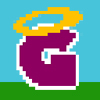 Game: The Simpsons: Bart’s Nightmare (1993)
Game: The Simpsons: Bart’s Nightmare (1993)
Developer: Sculptured Software
Publisher: Acclaim
Originally Released on: SNES, Mega Drive
Currently Available on: Currently Unavailable
There are some gaming adaptations of film or television properties that are undeniably good and which become successful. There are many more that are terrible games, or that stray so far from the source material that they are unrecognisable. Then, on an odd occasion, there might be a title that seems to tick many of the boxes, such as characters, atmosphere and setting, yet it simply won’t make for a good game. Either the chosen gameplay style doesn’t suit the source material, or it just isn’t enjoyable. But then, there are the abominations. The games where the memory alone sometimes results in you waking up in the middle of the night in a cold sweat, and that is a full eighteen years after its release!
The Simpsons: Bart’s Nightmare is definitely one of those titles. Somehow, it combines some really interesting ideas and wraps them up in an irritating, frustrating little ball. Yes, it all starts off nicely with authentic The Simpsons music and art style, prominently featuring the characters we all know and love. The level design has a lot of variety and draws together several different styles of play. It must also be said that the sound design – both music and digitised voices are of a decent standard, and the cartoon-style action is all very nice to look at and very faithful to the animated series. It sounds like great foundations on which to build a game. However, it is sadly let down by poor controls, little to no instructional help and a difficulty curve that is near-vertical.
 Lets start at the beginning. The plot is a simple one, Bart (the perennial slacker) has once again left all of his homework until the last minute. Falling asleep at his desk, he awakens in a strange world, that looks very much like his home on Evergreen Terrace, but doesn’t seem quite normal. This acts as a hub world inbetween various arcade style game modes. Bart has lost his homework and the player must travel throughout this new, unusual street to find pages from his notepad. Once found, each page will transport him to a level based around a specific school subject. Complete that and Bart will recover the page in question. Sounds easy right? Wrong! There are many factors trying to keep poor Bart from even reaching one of his pages, let alone completing the required stages. As you walk along Windy Street, mailboxes veer menacingly from one side of the street to the other, bouncing Saxophones that make you walk in reverse and old ladies trying to kiss you, who sap your score. To make things harder, jumping is awkward and the controls feel very sticky with button presses not yielding an action straightaway.
Lets start at the beginning. The plot is a simple one, Bart (the perennial slacker) has once again left all of his homework until the last minute. Falling asleep at his desk, he awakens in a strange world, that looks very much like his home on Evergreen Terrace, but doesn’t seem quite normal. This acts as a hub world inbetween various arcade style game modes. Bart has lost his homework and the player must travel throughout this new, unusual street to find pages from his notepad. Once found, each page will transport him to a level based around a specific school subject. Complete that and Bart will recover the page in question. Sounds easy right? Wrong! There are many factors trying to keep poor Bart from even reaching one of his pages, let alone completing the required stages. As you walk along Windy Street, mailboxes veer menacingly from one side of the street to the other, bouncing Saxophones that make you walk in reverse and old ladies trying to kiss you, who sap your score. To make things harder, jumping is awkward and the controls feel very sticky with button presses not yielding an action straightaway.
 If you are hit by some of the obstacles in the area, such as basketballs and televisions, or are hit by a speeding school bus, for example – Bart will lose one of the Z’s floating over his head. These act as a life bar when in Windy Street. When they are all lost, Bart will wake up and the game will end, with your score attained at that point determining the outcome of the game. Bart can regain his Z’s by obtaining Bubblegum and blowing it at the Z’s. If you successfully leap over a basketball, you are rewarded with his favourite mode of transport – the Skateboard – which makes you much faster. Bump into Principal Skinner and he will promptly dress you in a suit, which slows you down, but does make you impervious to enemy attacks. You could also run into the school bullies, who will pull you all over the screen, resulting in you taking damage from all the other enemies, or you may meet a Fairy version of your sister, Lisa, who delights in turning you into a frog, which severely limits your movement options. Collect powerups such as the soda can (which is a screen-clearing attack) to avoid some of these more difficult enemies.
If you are hit by some of the obstacles in the area, such as basketballs and televisions, or are hit by a speeding school bus, for example – Bart will lose one of the Z’s floating over his head. These act as a life bar when in Windy Street. When they are all lost, Bart will wake up and the game will end, with your score attained at that point determining the outcome of the game. Bart can regain his Z’s by obtaining Bubblegum and blowing it at the Z’s. If you successfully leap over a basketball, you are rewarded with his favourite mode of transport – the Skateboard – which makes you much faster. Bump into Principal Skinner and he will promptly dress you in a suit, which slows you down, but does make you impervious to enemy attacks. You could also run into the school bullies, who will pull you all over the screen, resulting in you taking damage from all the other enemies, or you may meet a Fairy version of your sister, Lisa, who delights in turning you into a frog, which severely limits your movement options. Collect powerups such as the soda can (which is a screen-clearing attack) to avoid some of these more difficult enemies.
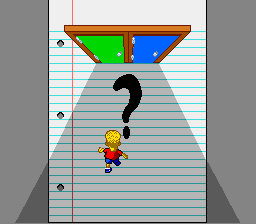 Sounds confusing right? Remember that this is only the hub world! We haven’t even entered a proper level yet! I haven’t even covered all of the aspects and features found in Windy Street, yet already most people would be confused about what does what; there is too much to remember already. It is this sort of confusion that reigns throughout most of the remainder of the title. So, time to try out the actual levels right? Upon entering the different pages, players will be given the choice of entering one of two randomly-selected coloured doors. The colours relate to the following:
Sounds confusing right? Remember that this is only the hub world! We haven’t even entered a proper level yet! I haven’t even covered all of the aspects and features found in Windy Street, yet already most people would be confused about what does what; there is too much to remember already. It is this sort of confusion that reigns throughout most of the remainder of the title. So, time to try out the actual levels right? Upon entering the different pages, players will be given the choice of entering one of two randomly-selected coloured doors. The colours relate to the following:
- The Green Door: Bartzilla – Bart is turned into a giant Godzilla-like creature, and must rampage through the streets.
- The Violet Door: Bart’s Bloodstream – Aka Inner Space, you are shrunk to the size of an atom, to battle germs.
- The Blue Door: Bartman – A side-scrolling shooter, where you play as Bart’s superhero alter ego.
- The Orange Door: Indiana Bart – As Indiana Jones, traverse collapsing platforms to reach a page
- The Yellow Door: Itchy & Scratchy – Battle the two feuding animals throughout the Simpson home.
Completion of each levels rewards Bart with one of the eight homework pages he requires. You’ve guessed it – to get all eight, you will need to complete some of the mini-game variants twice. Fail, and you drop back to Windy Street, a few Z’s worse off, with no homework pages to show for your efforts. You can retry the same levels, but this quickly becomes a frustrating exercise, as you have to once again track down another homework page, without taking too much damage and losing all of your Z’s, only to have to go through the same level you just failed on, and more often than not, on your return to Windy Street you will be accosted from all sides by a number of enemies with little to no time to get your bearings.
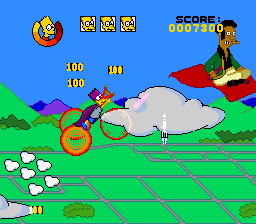 The problem with the mini-games is that most give you no sort of instruction as to what the aim of the game (or the controls for that matter) actually are. You are simply dropped in and expected to pick it up right away. Bartman is the easiest to pick up, and probably the least annoying. A simple side-scrolling shooter, Bart flies across the Springfield skies, with the aim being to defeat the evil Mr Burns. who has poisoned the skies with Radiation. The controls are simple and quick to pick up, and the enemies aren’t too cheap; most of them having patterns that can be learned and avoided. Barney and Smithers also make cameos as mini-bosses, whilst Apu will fly by on a Magic Carpet, to provide players with extra energy (the game really takes liberties with the whole “dream” idea, when it comes to weird situations). This level is actually quite enjoyable to play through despite the lack of variety and the degree of enemy re-use, which makes it all the more sad that there is only one available page linked to the Bartman level.
The problem with the mini-games is that most give you no sort of instruction as to what the aim of the game (or the controls for that matter) actually are. You are simply dropped in and expected to pick it up right away. Bartman is the easiest to pick up, and probably the least annoying. A simple side-scrolling shooter, Bart flies across the Springfield skies, with the aim being to defeat the evil Mr Burns. who has poisoned the skies with Radiation. The controls are simple and quick to pick up, and the enemies aren’t too cheap; most of them having patterns that can be learned and avoided. Barney and Smithers also make cameos as mini-bosses, whilst Apu will fly by on a Magic Carpet, to provide players with extra energy (the game really takes liberties with the whole “dream” idea, when it comes to weird situations). This level is actually quite enjoyable to play through despite the lack of variety and the degree of enemy re-use, which makes it all the more sad that there is only one available page linked to the Bartman level.
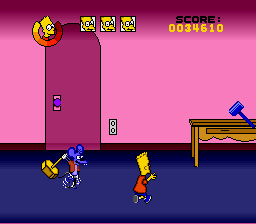 Luckily, the second most enjoyable stage, Itchy & Scratchy, has two slightly different levels, rewarding two pages if replayed. This is basically a side-scrolling beat-em-up, in the style of the Teenage Mutant Ninja Turtles games, or Double Dragon. You fight through either the upstairs or downstairs of the Simpson house (depending whether it is your first or second playthrough), defeating household items that have come to life, whilst avoiding the dueling cat and mouse. At several points you will have to fight the two in boss battles, which are frankly mayhem on the screen. Using the variety of weapons acquired in the level including mallets, plunger guns and fire extinguishers, you must defeat the two menacing animals, to gain another page. Luckily, these frantic boss battles are made easier by small exploits where standing in a certain position on screen will make you near invincible, with a clear shot at your enemies. Without these strategic hidey-holes, these levels would be almost impossible to beat. So factor in that some of the enemies are so fast, they whizz on-screen and cause you damage before you even know what is going on. Perhaps this stage is only one of the better ones, as it is compared to some truly horrible expereinces in other stages.
Luckily, the second most enjoyable stage, Itchy & Scratchy, has two slightly different levels, rewarding two pages if replayed. This is basically a side-scrolling beat-em-up, in the style of the Teenage Mutant Ninja Turtles games, or Double Dragon. You fight through either the upstairs or downstairs of the Simpson house (depending whether it is your first or second playthrough), defeating household items that have come to life, whilst avoiding the dueling cat and mouse. At several points you will have to fight the two in boss battles, which are frankly mayhem on the screen. Using the variety of weapons acquired in the level including mallets, plunger guns and fire extinguishers, you must defeat the two menacing animals, to gain another page. Luckily, these frantic boss battles are made easier by small exploits where standing in a certain position on screen will make you near invincible, with a clear shot at your enemies. Without these strategic hidey-holes, these levels would be almost impossible to beat. So factor in that some of the enemies are so fast, they whizz on-screen and cause you damage before you even know what is going on. Perhaps this stage is only one of the better ones, as it is compared to some truly horrible expereinces in other stages.
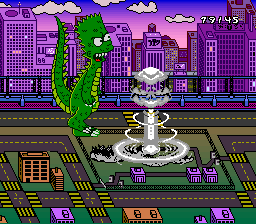 Now we move onto the more confusing levels. Playing as Bartzilla, the control method is never made clear. Enemies attack you from the air, ground and all around you, and must be defeated by using the correct attack, which is mapped to a specific button. The attacks are never made clear to the player however, and it is simple trial and error that gets you through this stage. Luckily, as Bartzilla, the player has such a surfeit of energy, you can almost just storm your way through the stage without a worry. That is only half the battle though. Now you find yourself scaling a sky-scraper like King Kong, having to shuffle from side-to-side to avoid falling objects. Get hit by one too many and you will fall – never reaching the homework page at the peak of the tower. You are armed with an electro-shock attack, but this is very short range and is only of use against certain enemies. But, like the rest of the game, the controls here are sluggish, which makes quickly avoiding a surprising item that is falling right at your character very hard. This is incredibly frustrating, as the character on-screen will often not respond to your commands in time, resulting in a lot of shouting at the TV.
Now we move onto the more confusing levels. Playing as Bartzilla, the control method is never made clear. Enemies attack you from the air, ground and all around you, and must be defeated by using the correct attack, which is mapped to a specific button. The attacks are never made clear to the player however, and it is simple trial and error that gets you through this stage. Luckily, as Bartzilla, the player has such a surfeit of energy, you can almost just storm your way through the stage without a worry. That is only half the battle though. Now you find yourself scaling a sky-scraper like King Kong, having to shuffle from side-to-side to avoid falling objects. Get hit by one too many and you will fall – never reaching the homework page at the peak of the tower. You are armed with an electro-shock attack, but this is very short range and is only of use against certain enemies. But, like the rest of the game, the controls here are sluggish, which makes quickly avoiding a surprising item that is falling right at your character very hard. This is incredibly frustrating, as the character on-screen will often not respond to your commands in time, resulting in a lot of shouting at the TV.
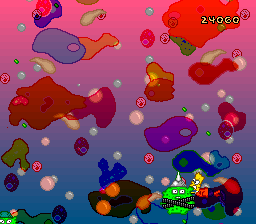 The final two levels are the shallowest and most repetitive. Bart’s Bloodstream sees players (armed with a bicycle pump) inflating and exploding germs who get close to them, whilst making their way to the next homework page. These levels are so simple and repetitive that the enemy patterns can be learnt and defeated quite simply, but there is no variety to the stages. It consists of the same action over and over again, and is certainly not very exciting. The same can be said for Indiana Bart, where you traverse sinking platforms in order to reach the goal. Platforms sink when leapt upon, but at the same time, others will begin to rise. It is a simple case of jumping between the highest pillars, never letting one get too low. Enemies will appear from time to time to distract you, but if you take your time, this level is once again quite straightforward, and sadly very repetitive once again. You just move from one side of the screen to the other, across the platforms, with no real skill involved. The level is over-long and a little boring, but lose your concentration because of this and you will no doubt be punished by a wayward enemy or sunken platform.
The final two levels are the shallowest and most repetitive. Bart’s Bloodstream sees players (armed with a bicycle pump) inflating and exploding germs who get close to them, whilst making their way to the next homework page. These levels are so simple and repetitive that the enemy patterns can be learnt and defeated quite simply, but there is no variety to the stages. It consists of the same action over and over again, and is certainly not very exciting. The same can be said for Indiana Bart, where you traverse sinking platforms in order to reach the goal. Platforms sink when leapt upon, but at the same time, others will begin to rise. It is a simple case of jumping between the highest pillars, never letting one get too low. Enemies will appear from time to time to distract you, but if you take your time, this level is once again quite straightforward, and sadly very repetitive once again. You just move from one side of the screen to the other, across the platforms, with no real skill involved. The level is over-long and a little boring, but lose your concentration because of this and you will no doubt be punished by a wayward enemy or sunken platform.
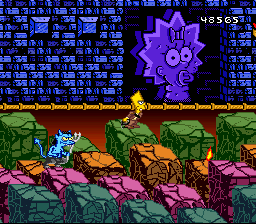 And that is the name of the game here; punishing your mistakes whilst rarely rewarding your good play. The more homework pages you retrieve, the better ending you will see when you finally lose all of your Z’s and leave dreamland. Collect few pages, and your family will de distraught. Gather several and they seem somewhat happier, but get all of the pages and your family will be overjoyed and you will see the true ending. It is fun to see a variety of endings, that are directly based on your in-game performance, but the fact that such repetition and grinding of boring stages is required tends to lead to the point where the player will rather give up than replay a frustrating stage, and with no save or password system to speak of, this game must be worked through in one punishing sitting.
And that is the name of the game here; punishing your mistakes whilst rarely rewarding your good play. The more homework pages you retrieve, the better ending you will see when you finally lose all of your Z’s and leave dreamland. Collect few pages, and your family will de distraught. Gather several and they seem somewhat happier, but get all of the pages and your family will be overjoyed and you will see the true ending. It is fun to see a variety of endings, that are directly based on your in-game performance, but the fact that such repetition and grinding of boring stages is required tends to lead to the point where the player will rather give up than replay a frustrating stage, and with no save or password system to speak of, this game must be worked through in one punishing sitting.
It is a shame that something so original and inventive could be hampered so much by unresponsive controls and lacklustre gameplay. It would have been helpful too, if the developers had included a bit more guidance to players within each mini-game, as some of the required action are quite hard to get the hang of in the heat of the moment, with no accounting for a tutorial. The hub by itself can be baffling and some gamers still contest that they never even got as far as entering any of the homework doors; the Windy Street finished them off before they got the chance.
 Granted, video games were famously much more difficult in the late eighties and the early nineties and it is true that developers didn’t hold the hand of the player as much as they do nowadays, but good game design should be logical and easy to learn. Controls that are nonsensical and confusing simply hamper a game – they don’t effectively increase the difficulty. Not being able to understand the controls or the object of a level isn’t simply the mark of a hard game, it just shows bad game design. Despite their best efforts in building a creative game world with the Simpsons assets and properties, the concept is let down by the execution. I would lke to make this game eat my shorts, but I’m not sure what buttons I would need to press to do that. This title was famous for the amount of publisher interference it experienced, and perhaps with a little more creative control, and less dictatorial instruction, the good ideas would have been able to shine through in the gameplay also.
Granted, video games were famously much more difficult in the late eighties and the early nineties and it is true that developers didn’t hold the hand of the player as much as they do nowadays, but good game design should be logical and easy to learn. Controls that are nonsensical and confusing simply hamper a game – they don’t effectively increase the difficulty. Not being able to understand the controls or the object of a level isn’t simply the mark of a hard game, it just shows bad game design. Despite their best efforts in building a creative game world with the Simpsons assets and properties, the concept is let down by the execution. I would lke to make this game eat my shorts, but I’m not sure what buttons I would need to press to do that. This title was famous for the amount of publisher interference it experienced, and perhaps with a little more creative control, and less dictatorial instruction, the good ideas would have been able to shine through in the gameplay also.
The Simpsons: Bart’s Nightmare is currently unavailable to purchase new, but can be bought second hand from sites such as eBay. The God is a Geek Retro Corner is part of “Feature Friday” and will return on the first Friday of next month. You can see previous entries into the GodisaGeek Retro Corner by clicking here.
Robin Parker
If I'm not playing on a good Adventure Game - still longing for the long-past Golden Age of the genre, when Lucasarts and Sierra ruled supreme - you might find me searching for a local arcade, in the hopes that it still houses titles such as Sunset Riders or WindJammers.





